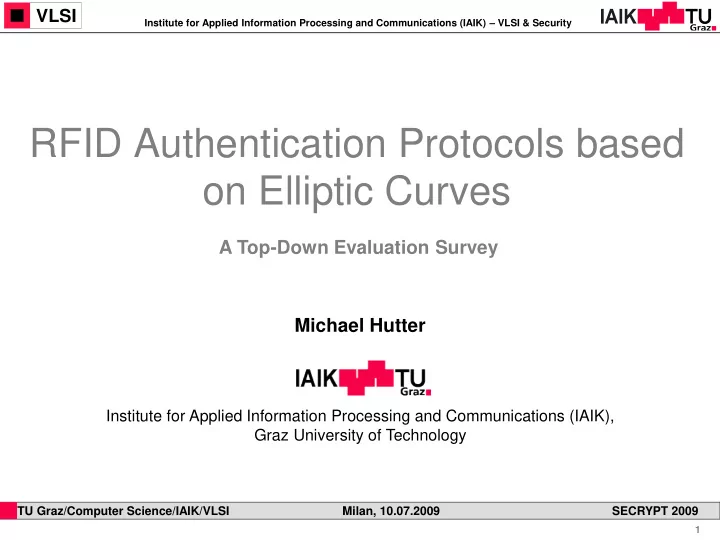

VLSI Institute for Applied Information Processing and Communications (IAIK) – VLSI & Security RFID Authentication Protocols based on Elliptic Curves A Top-Down Evaluation Survey Michael Hutter Institute for Applied Information Processing and Communications (IAIK), Graz University of Technology TU Graz/Computer Science/IAIK/VLSI Milan, 10.07.2009 SECRYPT 2009 1
VLSI Institute for Applied Information Processing and Communications (IAIK) – VLSI & Security Presentation Outline Introduction Cryptographic-Enabled RFID Tags Public-Key Authentication Techniques Authentication Protocols for RFID tags Schnorr, Okamoto, and GPS Performance Evaluation Identification Schemes Signature Schemes X.509 Certificates Conclusions http://www.iaik.tugraz.at TU Graz/Computer Science/IAIK/VLSI Milan, 10.07.2009 SECRYPT 2009 2
VLSI Institute for Applied Information Processing and Communications (IAIK) – VLSI & Security Introduction Radio-Frequency Identification (RFID) Wireless technology Identification of objects/entities Increases the performance of internal processes Improves supply-chain management and inventory control State-of-the-Art RFID Security No security: low-cost tags answer with a fixed identifier Reasonable security: tags use shared secrets/symmetric keys Memory write/read protection (e.g. iCode, …) Access control, ticketing (e.g. Mifare, CryptoRF, …) Enhanced security: electronic payment, e-passports, … http://www.iaik.tugraz.at TU Graz/Computer Science/IAIK/VLSI Milan, 10.07.2009 SECRYPT 2009 3
VLSI Institute for Applied Information Processing and Communications (IAIK) – VLSI & Security Cryptographic-Enabled RFID Tags ..would solve a lot of issues RFID is an effective tool to tackle the problem of counterfeited products International Chamber of Commerce estimates $650 billion a year (worldwide) ..but Cryptographic units need additional HW area = costs Key-distribution problem: more than 2 billion RFID tags will be sold worldwide in 2009 (according to IDTechEx) Symmetric vs. asymmetric cryptography Symmetric Crypto Asymmetric Crypto Keys 1 secret key 2 (1 private key, 1 public key) Key length 128-bit 300-2000-bit Key management Complicated (secure channel) Manageable (PKI) Computational complexity Reasonable High Power consumption Reasonable High http://www.iaik.tugraz.at TU Graz/Computer Science/IAIK/VLSI Milan, 10.07.2009 SECRYPT 2009 4
VLSI Institute for Applied Information Processing and Communications (IAIK) – VLSI & Security Our Objectives Cryptographic service Tag authentication (instead of identification) Key Management Asymmetric techniques (instead of symmetric) Light-weight implementations Low resources available (low power, area,…) Low costs Large deployment of tags (some billion tags) Challenge: find light-weight public-key authentication protocols for low-cost RFID tags http://www.iaik.tugraz.at TU Graz/Computer Science/IAIK/VLSI Milan, 10.07.2009 SECRYPT 2009 5
VLSI Institute for Applied Information Processing and Communications (IAIK) – VLSI & Security http://www.iaik.tugraz.at TU Graz/Computer Science/IAIK/VLSI Milan, 10.07.2009 SECRYPT 2009 6
VLSI Institute for Applied Information Processing and Communications (IAIK) – VLSI & Security Questions for RFID Applications: Which protocol/scheme/primitive to choose? What is the performance of existing RFID authentication protocols? Security, memory, computational complexity, communication Complexity of signature schemes compared to identification schemes? Entity vs. message authentication capabilities for RFID tags? What are the costs for storing X.509 certificates on the tag? … http://www.iaik.tugraz.at TU Graz/Computer Science/IAIK/VLSI Milan, 10.07.2009 SECRYPT 2009 7
VLSI Institute for Applied Information Processing and Communications (IAIK) – VLSI & Security Performance Evaluation Simulation of different RFID scenarios using Java Model of components (reader, tags, air-interface, TTP, …) 1) Performed certificate-size estimations for RFID tags 2) Evaluated different authentication protocols/schemes Schnorr, Okamoto, GPS Both identification and signature schemes All schemes are based on the recommended NIST elliptic curve over GF(p192) http://www.iaik.tugraz.at TU Graz/Computer Science/IAIK/VLSI Milan, 10.07.2009 SECRYPT 2009 8
VLSI Institute for Applied Information Processing and Communications (IAIK) – VLSI & Security Schnorr’s Identification Scheme Introduced by C.P.Schnorr in 1979 Interactive identification scheme Three-way witness-challenge-response protocol Provides a zero-knowledge proof-of-knowledge Can be applied using ECC (ECSchnorr) http://www.iaik.tugraz.at TU Graz/Computer Science/IAIK/VLSI Milan, 10.07.2009 SECRYPT 2009 9
VLSI Institute for Applied Information Processing and Communications (IAIK) – VLSI & Security Okamoto’s Identification Scheme Introduced by T.Okamoto in 1993 Provides additional security against active attacks Two scalar multiplications needed (Shamir’s trick can be applied) Provides a witness-indistinguishable proof-of-knowledge http://www.iaik.tugraz.at TU Graz/Computer Science/IAIK/VLSI Milan, 10.07.2009 SECRYPT 2009 10
VLSI Institute for Applied Information Processing and Communications (IAIK) – VLSI & Security GPS Identification Scheme Introduced by M.Girault, G.Poupard, J.Stern in 2001 Standardized in ISO/IEC 9798-5 in 2004 Eliminates modular reduction Allows fast “on-the-fly” authentication http://www.iaik.tugraz.at TU Graz/Computer Science/IAIK/VLSI Milan, 10.07.2009 SECRYPT 2009 11
VLSI Institute for Applied Information Processing and Communications (IAIK) – VLSI & Security X.509 Certificate-Evaluation Results Evaluated 3 scenarios: 1. store entire X.509 certificate 2. store compressed certificate 3. store only variable part [bytes] Schnorr Okamoto GPS Scenario 1 268 292 268 Scenario 2 243 267 243 Scenario 3 76 100 76 http://www.iaik.tugraz.at TU Graz/Computer Science/IAIK/VLSI Milan, 10.07.2009 SECRYPT 2009 12
VLSI Institute for Applied Information Processing and Communications (IAIK) – VLSI & Security Identification-Schemes Performance Service, memory usage, and Communication bandwidth computational complexity http://www.iaik.tugraz.at TU Graz/Computer Science/IAIK/VLSI Milan, 10.07.2009 SECRYPT 2009 13
VLSI Institute for Applied Information Processing and Communications (IAIK) – VLSI & Security Signature-Schemes Performance Service, memory usage, and Communication bandwidth computational complexity http://www.iaik.tugraz.at TU Graz/Computer Science/IAIK/VLSI Milan, 10.07.2009 SECRYPT 2009 14
VLSI Institute for Applied Information Processing and Communications (IAIK) – VLSI & Security Conclusions Analyzed different authentication protocols for low-cost RFID tags Each protocol provides different tradeoffs Schnorr provides best performance (100 bytes memory, ~1M cycles, ~130 bytes for communication) Okamoto provides enhanced security features (148 bytes memory, ~2M cycles, ~180 bytes for communication) GPS provides fast challenge-response computation (100 bytes memory, ~1.6M cycles, ~150 bytes for communication) ECC-based identification and signature schemes have nearly the same complexity Hash computation needs about 4000 additional clock cycles http://www.iaik.tugraz.at TU Graz/Computer Science/IAIK/VLSI Milan, 10.07.2009 SECRYPT 2009 15
VLSI Institute for Applied Information Processing and Communications (IAIK) – VLSI & Security Thanks for your attention! Questions? http://www.iaik.tugraz.at/ http://www.iaik.tugraz.at TU Graz/Computer Science/IAIK/VLSI Milan, 10.07.2009 SECRYPT 2009 16
Recommend
More recommend